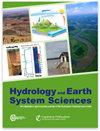Uncertainty in water transit time estimation with StorAge Selection functions and tracer data interpolation
IF 5.8
1区 地球科学
Q1 GEOSCIENCES, MULTIDISCIPLINARY
引用次数: 2
Abstract
Abstract. Transit time distributions (TTDs) of streamflow are useful descriptors for understanding flow and solute transport in catchments. Catchment-scale TTDs can be modeled using tracer data (e.g. oxygen isotopes, such as δ18O) in inflow and outflows by employing StorAge Selection (SAS) functions. However, tracer data are often sparse in space and time, so they need to be interpolated to increase their spatiotemporal resolution. Moreover, SAS functions can be parameterized with different forms, but there is no general agreement on which one should be used. Both of these aspects induce uncertainty in the simulated TTDs, and the individual uncertainty sources as well as their combined effect have not been fully investigated. This study provides a comprehensive analysis of the TTD uncertainty resulting from 12 model setups obtained by combining different interpolation schemes for δ18O in precipitation and distinct SAS functions. For each model setup, we found behavioral solutions with satisfactory model performance for in-stream δ18O (KGE > 0.55, where KGE refers to the Kling–Gupta efficiency). Differences in KGE values were statistically significant, thereby showing the relevance of the chosen setup for simulating TTDs. We found a large uncertainty in the simulated TTDs, represented by a large range of variability in the 95 % confidence interval of the median transit time, varying at the most by between 259 and 1009 d across all tested setups. Uncertainty in TTDs was mainly associated with the temporal interpolation of δ18O in precipitation, the choice between time-variant and time-invariant SAS functions, flow conditions, and the use of nonspatially interpolated δ18O in precipitation. We discuss the implications of these results for the SAS framework, uncertainty characterization in TTD-based models, and the influence of the uncertainty for water quality and quantity studies.StorAge选择函数和示踪数据插值法估算水传输时间的不确定性
摘要径流的渡越时间分布(TTD)是理解集水区流量和溶质运移的有用描述符。通过使用存储年龄选择(SAS)函数,可以使用流入和流出的示踪剂数据(如氧同位素,如δ18O)对集水区规模的TTD进行建模。然而,示踪剂数据在空间和时间上往往是稀疏的,因此需要对其进行插值以提高其时空分辨率。此外,SAS函数可以用不同的形式进行参数化,但对于应该使用哪种形式还没有达成一致。这两个方面都会在模拟的TTD中引起不确定性,并且尚未充分研究单个不确定性源及其综合影响。本研究对通过结合降水中δ18O的不同插值方案和不同的SAS函数获得的12个模型设置产生的TTD不确定性进行了全面分析。对于每个模型设置,我们发现了具有令人满意的流中δ18O(KGE > 0.55,其中KGE指的是Kling–Gupta效率)。KGE值的差异具有统计学意义,从而表明所选设置与模拟TTD的相关性。我们发现模拟TTD存在很大的不确定性,表现为95 % 中值传输时间的置信区间,最大变化在259和1009之间 d。TTD的不确定性主要与降水中δ18O的时间插值、时变和时不变SAS函数之间的选择、流量条件以及在降水中使用非空间插值δ18O有关。我们讨论了这些结果对SAS框架的影响,基于TTD的模型中的不确定性表征,以及不确定性对水质和水量研究的影响。
本文章由计算机程序翻译,如有差异,请以英文原文为准。
求助全文
约1分钟内获得全文
求助全文
来源期刊

Hydrology and Earth System Sciences
地学-地球科学综合
CiteScore
10.10
自引率
7.90%
发文量
273
审稿时长
15 months
期刊介绍:
Hydrology and Earth System Sciences (HESS) is a not-for-profit international two-stage open-access journal for the publication of original research in hydrology. HESS encourages and supports fundamental and applied research that advances the understanding of hydrological systems, their role in providing water for ecosystems and society, and the role of the water cycle in the functioning of the Earth system. A multi-disciplinary approach is encouraged that broadens the hydrological perspective and the advancement of hydrological science through integration with other cognate sciences and cross-fertilization across disciplinary boundaries.
 求助内容:
求助内容: 应助结果提醒方式:
应助结果提醒方式:


